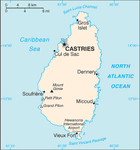Browse All Saint Lucian Recipes: Saint Lucian Appetizers | Saint Lucian Soups | Saint Lucian Salads | Saint Lucian Vegetarian | Saint Lucian Meat Dishes | Saint Lucian Snacks | Saint Lucian Desserts

|
This article is a stub! This article doesn't contain enough information. If you know anything about Saint Lucian Cuisine, please add to this article!
|
St Lucia - Cooking and Food[]
Overview of Saint Lucian Cuisine History[]
An accurate history of the Caribbean island of Saint Lucia can be found from the following link:
http://en.wikipedia.org/wiki/History_of_Saint_Lucia
Cuisines of St Lucia[]

Map of St Lucia- Click to enlarge
The volcanic and fertile soil of St. Lucia provides great conditions and it yields an enormous supply of produce. The island is also one of the main banana exporters in the Caribbean. Except bananas, St. Lucia’s abundant tropical fruits include papayas, coconuts, mangoes, pineapples, passion fruits, guavas, and soursops. Local St. Lucian chefs use a combination of fresh produce and a great variety of fresh seafood in order to prepare Creole-style entrees, curries, and pepperpot stews. The national St. Lucian dish is green fig (green banana) and salt fish. Another very popular dish is Cocoa tea which is made from cocoa beans that have been grounded and formed into sticks. The tea can be flavour with any number of spices such as cinnamon, nutmeg and bayleaf. It is usually served with a roasted bake or float which is similar to a jonny cake or fried bread. Being a rich cultural heritage, St. Lucia’s cuisine is given a great importance.
Preparation Methods for Saint Lucian Cooking[]
St. Lucian cuisine uses elements from various cooking traditions borrowed from their neighbours and developed from their own traditional dishes. While there are no specific or unique preparation methods for St. Lucian cooking, we should point out that attention to detail is important in the St. Lucian cuisine. Using the right amount of spices for example is essential - either for spicing up the taste or for coloring the dish. The diversity of vegetables and cereals found in St. Lucia is also noticed in the delicious dishes belonging to their cuisine. The visual attractiveness of the dish is also important, and a balance between colors and proportion differentiates. Each traditional dish has a special cooking method, which is more or less general in all of St. Lucia's regions. Meat is one of the main elements of most St. Lucian dishes and cured and smoked hams are often parts of delicious dishes.
Special Equipment for Saint Lucian Cooking[]
Ranging from cake pans, can openers, colanders, egg rings, poachers and holders, food dishers & portioners, food pans & food containers to other kitchen utensils, such as food scales, food scoops and fryer baskets & accessories, the St. Lucian cuisine needs a diverse cooking equipment set in order to produce the most sophisticated St. Lucian dishes. You should consider insulated food carriers if you are transporting the food and a full set of kitchen linens and uniforms if you wish to look like a pro. Here are a few other items that will come handy while cooking St. Lucian food: juicers, kitchen knives, kitchen slicers, kitchen thermometers, measuring cups & measuring spoons, miscellaneous utensils, mixing bowls and skimmers & strainers. Essential utensils like serving spoons, spatulas, forks, turners, scrapers and tongs should also be part of your cooking "arsenal".
Saint Lucian Food Traditions and Festivals[]
The St. Lucian year is marked by several festive events like Carnival and Calypso celebrations, or street parties. One of the most important events is St. Lucia Jazz Festival that takes place every year, between the May 8th-11th. These are great occasions to have Piton which is beer, and Bounty Rum all manufactured locally. Food is meant to bring people together, but it also means sharing. Fruits seem to be the most delicious and healthy food in St. Lucia, as well as fresh vegetables. One should never forget about St. Lucia’s national dish, green banana (also known as green fig to the locals) and saltfish.
People in St Lucia Food[]
- Are you into Saint Lucian Cooking and would like to be interviewed?
There are many chefs who creatively use the basic ingredients and cooking method for traditional St. Lucian dishes and create original and delicious food variations. St. Lucian chefs are passionate about their traditional dishes and they enjoy presenting them to foreigners who have never tasted them before. Whether they are cooking dishes that go back in time for centuries or brand new, modern dishes, St. Lucian chefs take pride in what they do, and this is readily noticeable in the unforgettable taste of their cooking.
